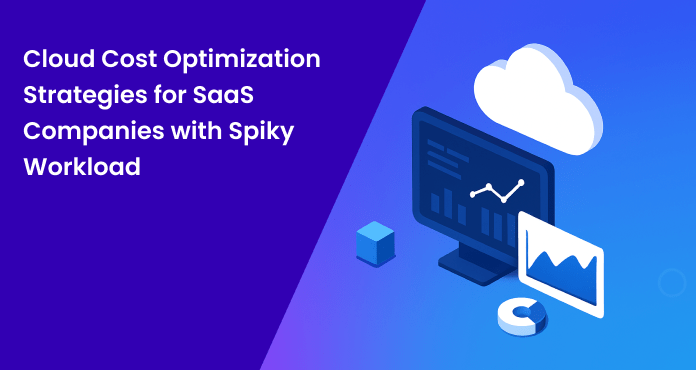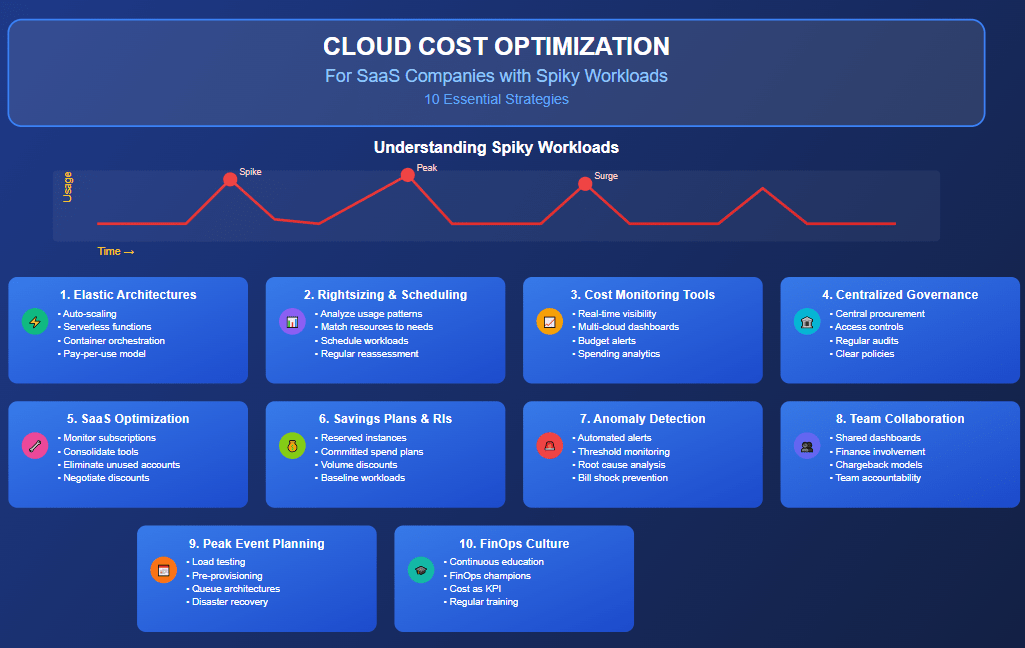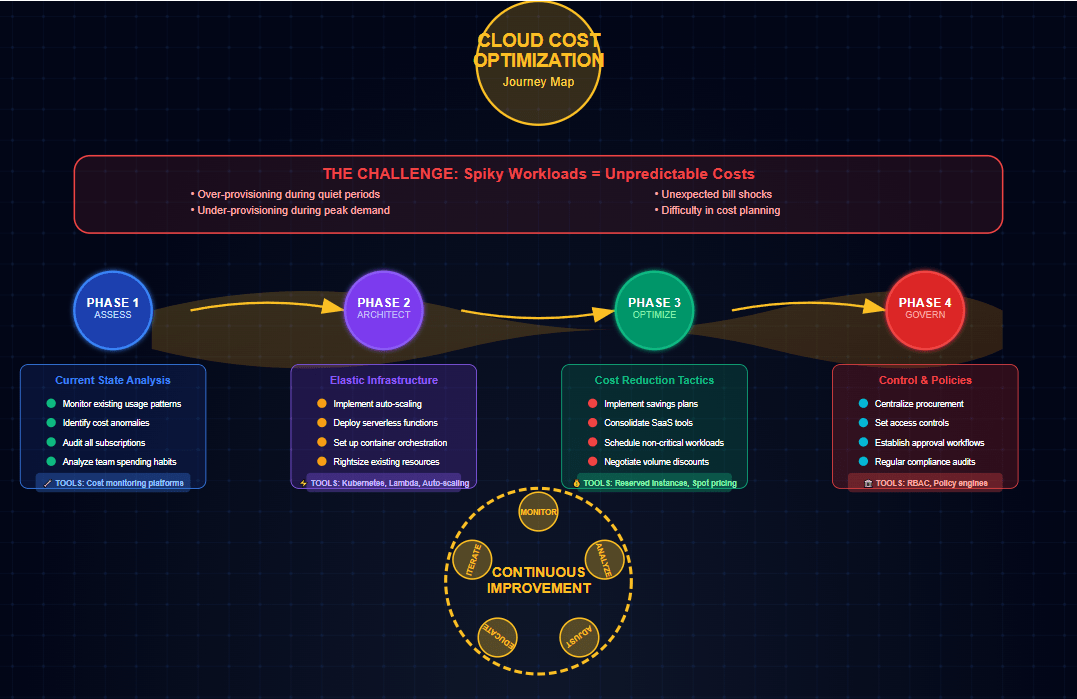
Introduction
Cloud adoption has revolutionized the way SaaS companies deliver value to customers. The cloud’s promise of scalability, agility, and pay-as-you-go pricing perfectly aligns with the on-demand nature of SaaS products. However, for many SaaS businesses—especially those dealing with spiky workloads (periods of unpredictable, high-volume activity)—cloud costs can quickly spiral out of control.
Imagine launching a new feature, running a global marketing campaign, or simply dealing with organic usage peaks. Spiky demand creates financial unpredictability and makes it challenging to optimize cloud expenditure. So, what are the most effective strategies for SaaS companies to manage and optimize their cloud costs, particularly in volatile usage scenarios?
Let’s break down actionable strategies to help SaaS companies rein in costs, maximize efficiency, and ensure they’re getting the most value from every cloud dollar spent.
Understanding Spiky Workloads in SaaS
Spiky workloads are characterized by sudden surges in demand for compute, storage, or network resources. This could be due to seasonal user growth, viral campaigns, batch processing jobs, or even unplanned spikes from customer usage. These unpredictable bursts make traditional cost planning difficult and can lead to:
- Over-provisioning (paying for idle resources)
- Under-provisioning (performance bottlenecks)
- Bill shocks from cloud providers
The first step to optimization is recognizing the unique challenges posed by spiky workloads and designing a cost strategy tailored for dynamic environments.

Strategy 1: Embrace Elastic Cloud Architectures
One of the biggest advantages of cloud computing is elasticity. Cloud-native architectures—built on containers, microservices, and serverless technologies—allow SaaS companies to scale up or down in response to real-time demand. This ensures you pay only for what you use.
Best practices include:
- Auto-scaling: Automatically adjust the number of compute instances (e.g., AWS EC2, Azure VM) based on usage.
- Serverless functions: Use serverless platforms (like AWS Lambda) to run code in response to events, eliminating the need to maintain idle infrastructure.
- Container orchestration: Leverage Kubernetes or similar tools to scale containers up and down seamlessly.
Elastic architectures let you weather usage spikes without overspending during quieter periods.
Strategy 2: Implement Rightsizing and Resource Scheduling
Rightsizing is the process of matching cloud resources to actual workload requirements. Overprovisioned resources are a silent cost killer, especially when trying to prepare for possible spikes.
How to rightsize effectively:
- Analyze usage patterns: Identify VMs, containers, or databases that are consistently underutilized.
- Adjust resource allocations: Downgrade over-provisioned resources to lower-cost instances or scale down where possible.
- Schedule workloads: Use cloud-native tools to shut down non-critical environments (like dev/test) outside business hours.
For SaaS companies, it’s crucial to revisit resource allocations regularly, especially after high-traffic events or releases.
Strategy 3: Leverage Cloud Cost Management and Monitoring Tools
Real-time cost visibility is essential for making informed decisions. Modern SaaS operations require robust tools to track spending, detect anomalies, and forecast future costs.
Platforms like Binadox empower SaaS companies to:
- Consolidate multi-cloud and SaaS app expenses in a single dashboard
- Analyze usage and spending by department, team, or product line
- Set up alerts for budget overruns or anomalous spikes
- Generate actionable recommendations for cost savings
Key benefits of using cost management platforms:
- Immediate detection of spend spikes
- Data-driven rightsizing suggestions
- Proactive renewal and license management
These tools don’t just reveal where money is going—they empower teams to act on the insights.
Strategy 4: Centralize Procurement and Governance
Uncontrolled SaaS and cloud procurement can lead to duplicate subscriptions, unused licenses, and shadow IT—all of which drive up costs and risk. Centralized procurement and governance policies prevent waste and support smarter decision-making.
Effective tactics include:
- Central procurement portal: Mandate all cloud and SaaS purchases through a single, tracked system.
- Access controls: Limit who can spin up new cloud resources or subscribe to SaaS platforms.
- Regular audits: Periodically review all subscriptions, licenses, and resources for usage and value.
- Clear policies: Define guidelines for who can approve purchases and on what basis.
Governance is especially critical for SaaS businesses with global or distributed teams, where individual departments may purchase overlapping solutions.

Strategy 5: Monitor and Optimize SaaS Subscriptions
For SaaS companies, cloud cost optimization isn’t limited to infrastructure—it’s also about managing your own SaaS stack. As companies scale, the number of SaaS subscriptions grows, leading to overlapping tools, unused features, and waste.
Optimization tips:
- Use platforms like Binadox to discover, monitor, and analyze all SaaS applications deployed across your organization
- Set up automated reminders for contract renewals, price hikes, and upcoming license expirations.
- Consolidate redundant tools and eliminate unused accounts.
- Negotiate enterprise agreements or volume discounts with key vendors.
Strategy 6: Take Advantage of Cloud Savings Plans and Reserved Instances
Cloud providers offer several pricing models beyond on-demand pricing:
- Reserved Instances (RIs): Commit to a certain level of usage over a period (e.g., one or three years) in exchange for lower rates.
- Savings Plans: Flexible options that offer discounts based on committed spend rather than specific resources.
SaaS companies with predictable baseline workloads can use RIs or savings plans for “always-on” needs, while leaving the rest of their stack elastic to handle spikes.
Tip: Regularly review usage reports to shift more workloads to discounted plans where appropriate.
Strategy 7: Detect and Respond to Cost Anomalies
A key pain point for SaaS companies with spiky workloads is unexpected bill spikes—sometimes due to bugs, misconfigurations, or DDoS attacks.
Action steps:
- Enable anomaly detection in your cloud cost management tool.
- Set up automated alerts for when spend exceeds forecasted thresholds.
- Conduct regular root-cause analysis on anomalies to prevent recurrence.
For real-world examples and hands-on advice, check out Binadox’s client demo walkthrough.
Strategy 8: Foster Collaboration Between Engineering and Finance
Cloud cost optimization is a team sport. DevOps, engineering, and finance teams should share ownership of cloud costs.
Best practices:
- Make cost metrics visible to all stakeholders (dashboards, reports).
- Involve finance in capacity planning and architectural decisions.
- Implement chargeback or showback models so each team understands its spend and impact.
This collaborative approach promotes accountability and continuous improvement.
Strategy 9: Plan for Peak Events and Disaster Recovery
Not all spikes are unpredictable. Some—like product launches, Black Friday, or end-of-month billing runs—are planned events. Prepare in advance by:
- Load-testing your infrastructure to find the most cost-efficient scaling strategies.
- Pre-provisioning only the minimum necessary baseline resources.
- Using auto-scaling and queue-based architectures to absorb sudden load.
- Setting up disaster recovery policies that balance cost with acceptable risk.
A proactive approach ensures you’re prepared for both the expected and the unexpected.
Strategy 10: Continuous Education and Cloud FinOps Culture
Cloud platforms, billing models, and optimization best practices evolve rapidly. Building a culture of FinOps—the practice of financial management in the cloud—keeps your team ahead.
- Host regular training on cloud cost optimization techniques.
- Assign a FinOps champion or team responsible for ongoing monitoring.
- Encourage all teams to treat cloud cost as a core performance metric.
Learn about the broader trends shaping SaaS and cloud cost management at Binadox’s coverage of the COVID-19 impact on technology

How Binadox Supports SaaS Companies with Spiky Workloads
Binadox is purpose-built to help SaaS companies achieve full visibility, control, and optimization over both their cloud and SaaS spend—even in environments where workload volatility is the norm.
Core features include:
- Multi-cloud and SaaS dashboard: Unify all spending and usage data.
- Automated savings recommendations: AI-driven insights into rightsizing, eliminating unused resources, and identifying cheaper alternatives.
- License manager and renewals calendar: Avoid costly surprises by keeping all subscriptions in check.
- Cost explorer and anomaly detection: Instantly identify unusual spikes or billing errors.
- Custom tags and spend segmentation: Attribute costs by team, project, region, or customer.
For a full list of tools and capabilities, see Binadox Tools.
Real-World Examples and Results
Companies leveraging Binadox have achieved:
- Up to 30% reduction in cloud waste through automated recommendations and actionable insights
- Improved renewal management and vendor negotiations via centralized license tracking
- Faster detection of spend anomalies, preventing budget overruns before they happen
- Enhanced collaboration between technical and finance teams, supported by transparent reporting
Conclusion: Make Cloud Spikes Your Advantage
For SaaS companies, the agility to handle spiky workloads is a competitive advantage—but only if cloud costs are under control. By embracing elastic architectures, rightsizing resources, leveraging robust cost management tools, and fostering a culture of ongoing optimization, SaaS businesses can maximize their ROI on every cloud dollar.
Ready to take control of your SaaS and cloud spending? Start optimizing with Binadox today

